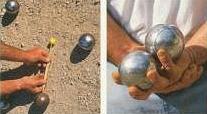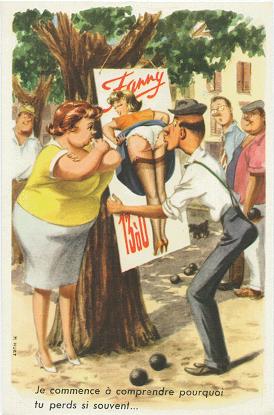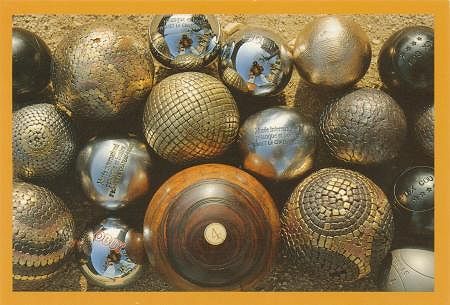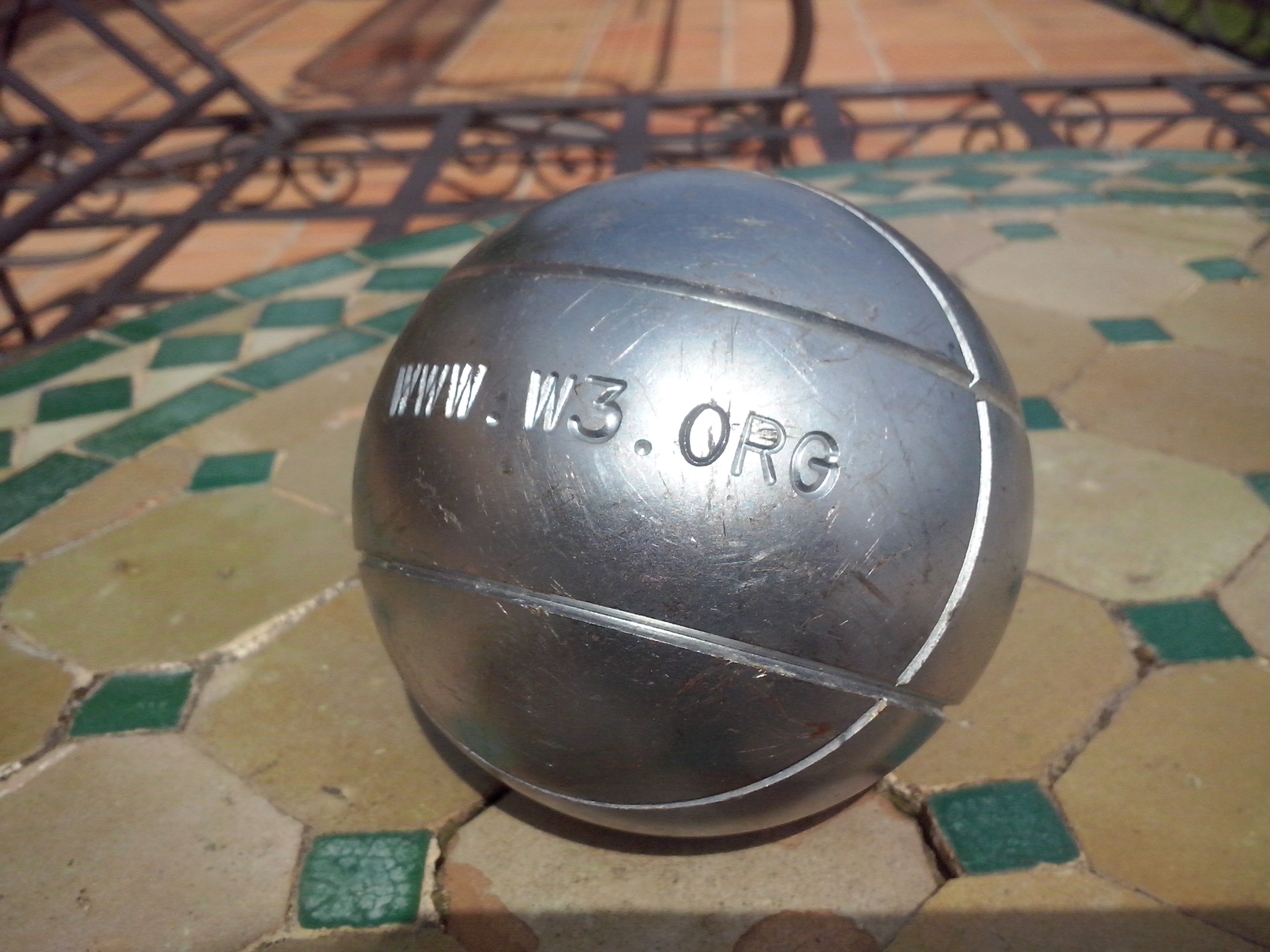For the third W3C Team face-to-face meeting, held in
southern France in November 2001, a set of Boules
de Pétanque was offered to each Team member.
This W3C Note is intended to give the W3C Team some information about the
game: where it comes from and how to play it.
This document is a Note made available by the W3C Sophia Team for use
originally by the rest of the W3C Team worldwide, and by anyone finding it
useful. It is appropriate to use this Note as reference material when playing
Pétanque with your W3C colleagues or friends. While the authors welcome
comments on this document, be warned the authors will probably try bend the
rules so that the French always win in international competitions (likely to
happen anyway <confident smile>).
Also available by the same authors is a list of current W3C technical
reports and publications.
Pétanque is a French (Provençal to be
precise) outdoor game played by two opposing teams trying to throw boules (metallic spheres the size of an orange) as
close as possible to a but (little wooden
sphere the size of a plastic bottle cork, also called a cochonnet, meaning piglet).
1.1 The History of Pétanque
The game of pétanque was devised in 1910, in a charming little town between
Marseille and Toulon called La Ciotat. In those days, the
locals played the so-called jeu provençal,
which is now much less popular than pétanque. The rules of the jeu provençal stipulate that, before throwing the
boule, a player must gain momentum by taking one or two running steps.
It happened one day that one of the game's great figures, a certain Jules
LeNoir, was confined to a wheelchair as a result of an accident. He was
mortified, believing that this would deprive him of the pleasure of the game
forever.
The other villagers, however, were so concerned for their friend that they
voted to change the rules of the game so that he would not be disadvantaged.
The new rules eliminated the running requirement; in pétanque, players must
throw the boule from within a circle scratched in the dirt, without running
steps. In the dialect of the region, it was said that one had to play "pieds
tanqués" (feet stuck, pé tanca in Provencal), and so was born a new variant
of the game.
It is to be noted that, to this day, this convention continues to permit
physically disabled persons to excel at pétanque; wheelchairs are a very common
sight at national and international pétanque championships. As with Web
Accessibility, this is another example of the famous "curb cut" effect in
action: the revised game proved more approachable to more people, seniors in
particular, and consequently grew in popularity while the jeu provençal ceased to be practiced.
Pétanque is the most common variant of the jeu
de boules, the collective name for many games involving boules and a but, that also
includes the English bowls. Jeux de boules
have been played in France in one form or another since the Romans introduced
it. (Jeux de boules are, of course, very "I18N": the Romans got it from the
Greeks, improving the game rather significantly by adding the but.) It lost some of its popularity after the Middle Ages, but
continued to be played in Provence in the southeast of France. In the 20th
century, the game again spread over France. Since World War II, pétanque has
been steadily increasing in popularity in European and beyond as a summer
recreational activity.
- The boules are not expensive and last a
lifetime;
- Little or no special preparation is needed for the playing surface;
- You can play almost anytime, wind ok, umbrella ok
- Everything you need to play fits into a small box;
- No great strength or athleticism is required;
- People of all ages and gender can compete on an equal basis;
- The rules and strategy of the game are easy to learn;
- Pétanque is a wonderful centerpiece for more general social activity such
as picnics, camping trips, or family outings. In French villages, the place
where pétanque is played is often central and an important discussion and
meeting place.
Pétanque can also serve as a test for those couples planning to wed: if,
while playing together, they can finish the game without screaming at each
other (or worse, throwing boules at one another), then they can be confident
that they are prepared for a long and happy life together <grin>.

2.1 Basic Rules
This section is normative
Teams. The game is always played by two
teams, each team must have an equal number of players, ranging from 1 to 4
players. Each player plays with 2 to 3 boules. The maximum number of boules per
team must never exceed 12, as a consequence, players in teams of 3 or 4 players
must use only 2 boules.
Goal. The goal of the game is for each team to get the most
boules closest to the but/cochon.
Play area. The Teams throw their boules in an open or
closed roughly rectangular play area, delimited by an organizing committee or
judge, that is approximately 4 meters by 15 meters. The play area should be
flat, and reasonably free of fragile or valuable things, such as Porsche
automobiles and small children.
Throwing area. Players throw their boules from within a
circle (or half-circle) drawn on the ground, approximately 50cm in diameter. As
play proceeds, the location of this circle within the play area changes. All
players must have their feet inside the circle when it is their turn to throw a
boule. When it is not their turn, the other
players should enjoy a cold pastis
(anisette-flavored liqueur popular in this part of France and in many other
countries) and should avoid interfering with each other's throws. You
must not touch a boule once it has been thrown in the play
area. Pastis may be enjoyed outside of the context of pétanque, and should be
consumed with moderation.
Game. Each game begins by drawing a throwing circle, then
throwing the but approximately 6 to 10 meters
away from the circle. For leisure activities, this rule may be bent to
accommodate players' needs. The first player of Team A throws a boule as close
to the but as possible; the boule may touch
the but (indeed, that's ideal). The first player of Team B then throws a boule.
Thereafter, which Team throws depends on which Team has the closest boule to
the but: the Team that does not have the closest boule throws
(and may have to throw several boules in a row), until either it places a boule
closer to the but than a boule of the other Team, or until it runs out of
boules. The order of players in a given Team does not matter, and a player may
throw more than one boule in a row. The game ends when both Teams have run out
of boules. The winning Team is the one with one or more boules closest to the
but.
Match. A match (or, partie de
boules) consists of any number of games required to reach a target score,
usually 13 points. Points are determined as follows: for each game, the winning
Team adds to its score the number of boules that are closer to the but than the
closest opponent boule. Thus, if Team A's closest boules are 1 meter and 3
meters from the but, and Team B's closest boule is 5 meters from the but, Team
A earns two points. See measurement below.
For more information, refer to Pétanque: The Basic Rules [RULES] or Wikipedia on Pétanque.
2.2 Measurements

While in many cases, Teams can determine which boule is closest to the but
without much argument, occasionally it becomes necessary to call upon the
consensus-building talents of the participants. This usually takes the form of
a measuring device, which may be as precise as a measuring tape or even a laser
pointer, or as informal as the length of a shoe (carefully not touching any
boule, or that would be a disaster).
2.3 Tireurs and Pointeurs
It is not only common for a thrown boule to strike another already in the
play area, it is often desirable as a means of displacing the boule of an
opponent. Indeed, there are two ways to reach the goal of having a boule close
to the but: place one close to the but, or displace the boule of an opponent.
These two approaches are embodied in two pétanque roles called the tireur (one skilled in trowing fast and knocking
boules out of place) and the pointeur (one
skilled in slow positioning a boule nearest to the but, potentially touching
others). Teams should consist of at least one pointeur and one tireur, as they
tend to complement one another.
Before starting a shoot, the player whose turn it is to play SHOULD debate
with his/her team whether (French verbs) pointer or tirer is
in order. Players MAY debate heavily on that question.
See this page on throwing
Techniques (in French, with images) for more details.
2.4 Fanny's rule

A pétanque loser suffering the indignation of the "baiser Fanny".
There is this one special rule that one should not forget
when engaging in a partie de boules: If the
losing Team has scored zero points (i.e., the final score is 13 - 0), the
players on the losing Team must do a "baiser
Fanny", which means "kiss Fanny's ass".
There are various ways to implement this rule: losers may be required to
kiss a picture of Fanny (see image) or a little sculpture. There are, of
course, other implementations possible...
2.5 Conforming boules
This section is normative

A picture of some old and modern boules.
A conforming set of pétanque boules must be certified by the French Pétanque
Fédération and must have the following characteristics:
- be made of metal;
- have a diameter between 7.05 cm (minimum) and 8 cm. (maximum);
- have a weight between 650 grams (minimum) and 800 grams (maximum). The
label (company trademark) and the numbers corresponding to the weight must
be engraved on the boules and always be readable;
A personal mark (player's name or initials, logos) may be engraved if this
does not change the fabrication conformance. For our W3C team meeting, we
bought conformant triplettes from OBut and had WWW.W3.ORG engraved on them, as
shown in the picture at the top.
- Boule
- A boule is a ball made of metal. It
can be conformant (see definition above) and used in competition or for
leisure or it can be used only for recreational use (and doesn't have to
be conformant, and can even be in wood, or in plastic; in fact, a non
conformant Boule doesn't even have to be a ball).
- But
- A but is a small wooden (or else)
ball, its diameter must be no less than 25mm and no more than 35mm, it
may be colored. Another word for but is cochonnet, which means "piglet".
- Pastis
- An anisette liquor to enjoy with moderation after playing boules.
Whoever has commented on this Note from the Sophia team as well as Ian.
- [RULES]
- Pétanque: The Basic
Rules, from Pétanque
America, available at http://petam.com/petanque.htm.




